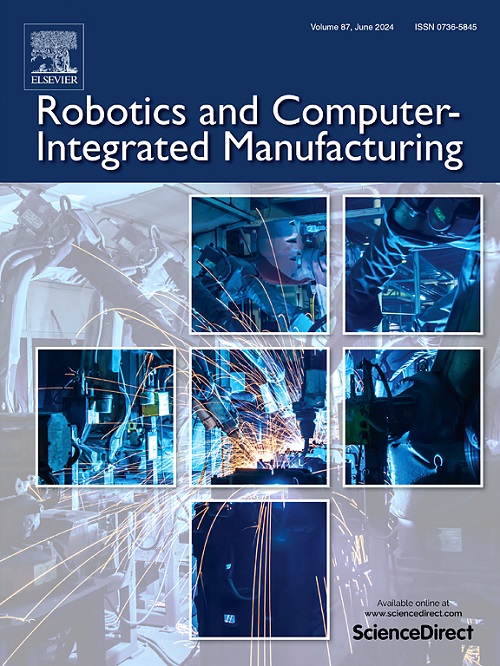Jerk-optimal force and motion synchronous planning for a 3-DOF translational force-controlled end-effector
IF 9.1
1区 计算机科学
Q1 COMPUTER SCIENCE, INTERDISCIPLINARY APPLICATIONS
引用次数: 0
Abstract
The 3-DOF Translational Force-controlled End-effector (TFE) based on 3-P(UU)2 Parallel Mechanism (PM) and pneumoelectric actuator is developed for polishing process performed by industrial robots, in which synchronous force and motion planning is critical to enhance the polishing performance. However, conventional planning methods are mainly developed to generate the trajectory for robotic motion control. Utilizing periodic splines, a new jerk-optimal Force and Motion Synchronous Planning (FMSP) method is proposed for the 3-DOF TFE to improve the force control stability between the tool and environment. Both the kinematics of the 3-DOF translational PM and the dynamics of the hybrid serial-parallel and macro-mini robotic system are established through screw theory. By introducing septuple B-splines for motion trajectory and cubic splines for contact force with periodic boundary conditions, the jerk-optimal performance index of motion and force is employed to formulate the FMSP model in Cartesian space. Simulation and experimental results demonstrate that the high-order continuity of the active driving force, moving acceleration and jerk-optimal performance index generated by FMSP is preferable compared to the Trajectory Planning with Point-to-point Force (TPWPF) and the Force-motion Linear Interpolation (FMLI) methods. The unloaded force peaks caused by the motion impact are reduced by 21 % and 22.6 % along x and y direction, respectively. Furthermore, the peaks of the contact force between the tool and workpiece decrease by 31.5 % and 20.4 % owing to slighter systemic vibration and impact. The FMSP method for force-controlled end-effector shows great potential in robotic continuous contact operations.
3-DOF 平移力控末端执行器的 "搐动 "优化力和运动同步规划
基于3-P(UU)2并联机构(PM)和气动执行器的3-DOF平移力控制末端执行器(TFE)用于工业机器人的抛光过程,其中同步力和运动规划是提高抛光性能的关键。然而,传统的规划方法主要用于生成机器人运动控制的轨迹。为了提高刀具与环境之间的力控制稳定性,提出了一种基于周期样条曲线的三自由度TFE力与运动同步优化规划方法。利用螺旋理论建立了平移式三自由度永磁机器人的运动学和串-并联和宏-微型混合机器人系统的动力学。通过在周期边界条件下引入七次b样条运动轨迹和三次接触力,利用运动和力的跳变最优性能指标在笛卡尔空间中建立了FMSP模型。仿真和实验结果表明,与点对点力轨迹规划(TPWPF)和力-运动线性插值(FMLI)方法相比,FMSP生成的主动驱动力、运动加速度和跳变优化性能指标具有较高的连续性。运动冲击引起的卸载力峰值沿x和y方向分别降低了21%和22.6%。此外,由于较轻的系统振动和冲击,刀具与工件之间的接触力峰值降低了31.5%和20.4%。力控末端执行器的FMSP方法在机器人连续接触操作中显示出巨大的潜力。
本文章由计算机程序翻译,如有差异,请以英文原文为准。
求助全文
约1分钟内获得全文
求助全文
来源期刊
CiteScore
24.10
自引率
13.50%
发文量
160
审稿时长
50 days
期刊介绍:
The journal, Robotics and Computer-Integrated Manufacturing, focuses on sharing research applications that contribute to the development of new or enhanced robotics, manufacturing technologies, and innovative manufacturing strategies that are relevant to industry. Papers that combine theory and experimental validation are preferred, while review papers on current robotics and manufacturing issues are also considered. However, papers on traditional machining processes, modeling and simulation, supply chain management, and resource optimization are generally not within the scope of the journal, as there are more appropriate journals for these topics. Similarly, papers that are overly theoretical or mathematical will be directed to other suitable journals. The journal welcomes original papers in areas such as industrial robotics, human-robot collaboration in manufacturing, cloud-based manufacturing, cyber-physical production systems, big data analytics in manufacturing, smart mechatronics, machine learning, adaptive and sustainable manufacturing, and other fields involving unique manufacturing technologies.

 求助内容:
求助内容: 应助结果提醒方式:
应助结果提醒方式:


